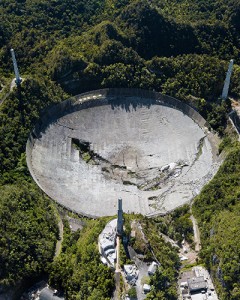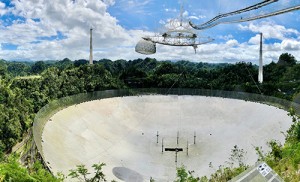Giant Telescope Collapses

The dish of Arecibo Observatory’s radio telescope lies heavily damaged following the collapse of the instrument platform on Dec. 1, 2020.
Credit: © estadespr, Shutterstock
The year 2020 claimed yet another victim, with the destruction of one of the most impressive telescopes ever built—the radio telescope at Arecibo Observatory. Already damaged beyond repair, the remaining cables that held the telescope’s instrument platform snapped on December 1, sending the platform crashing through the dish below. It was a spectacular and disappointing end to a telescope that has done so much to further our understanding of the universe.
The radio telescope was the primary instrument at the observatory, located in Puerto Rico, 50 miles (80 kilometers) west of San Juan. A radio telescope collects and measures radio waves given off by objects in space. At 1,000 feet (305 meters) in diameter, the Arecibo radio telescope was the world’s most powerful when it opened in 1963. It remained the largest dish (bowl-shaped reflector) in the world until 2016, when the dish of the Five-hundred-meter Aperture Spherical radio Telescope (FAST) was completed in Guizhou Province, China.
The Arecibo dish was built into a natural basin-shaped valley. The dish focused radio waves onto receivers mounted on the large instrument platform suspended above. The waves came from such distant objects as pulsars (rapidly spinning stars whose waves arrive on Earth as regular pulses). Arecibo astronomers discovered the first binary pulsar (a pulsar in orbit around a companion star) in 1974. In the early 1990′s, astronomers at the observatory discovered planets beyond the solar system and ice at the poles of Mercury. Until the middle of 2020, astronomers were using the radio telescope for a variety of astronomical observations, including monitoring and assessing the threat level of near-Earth asteroids.

The Arecibo Observatory radio telescope as it appeared before its collapse in 2020. The instrument platform (top center) crashed through the dish on December 1.
Credit: © Than Tibbetts, Shutterstock
The impressive appearance of the massive dish surrounded by the lush, forested hills of Puerto Rico’s interior seemed particularly to capture the public imagination. The radio telescope appeared in the sci-fi motion picture Contact (1997) and the James Bond film GoldenEye (1995), for example.
The final collapse of the telescope began in August 2020, when an auxiliary cable that held the instrument platform broke. The falling cable tore several large gashes in the dish. In November, before engineers had a chance to repair the dish or replace the cable, a main support cable broke. The United States National Science Foundation (NSF) quickly determined that the telescope could no longer be saved without putting lives at risk. The NSF was considering plans to decommission the telescope—taking it permanently out of service—when the collapse occurred.
The future of the Arecibo Observatory appears doubtful. The U.S. Congress could direct funds to replace the telescope, but it may be more likely that the facility will be closed permanently.
In 1975, scientists engaged in the search for extraterrestrial intelligence used the dish from the Arecibo telescope to beam a powerful signal into space. This signal was designed by astronomer Frank Drake with the help of famous science popularizer Carl Sagan to give any intelligent being who discovers it information about Earth and humans. Encoded within the message was an image of the dish itself. Although it is unlikely that any alien civilizations will receive the message, it serves a lasting monument to the telescope’s legacy.


